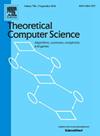三维关节机器人探针轨迹规划的组合表征与算法
IF 1
4区 计算机科学
Q3 COMPUTER SCIENCE, THEORY & METHODS
引用次数: 0
摘要
考虑一个包含n个不相交的三角形障碍物和一个目标点的三维工作空间。我们将两段铰接式探测器的轨迹规划问题定义为计算一条使探测器到达目的地同时避免与障碍物碰撞的可行路径的任务。铰接探头受限于一系列运动-直线插入可能随后是末端段的旋转。当探测器或其路径与障碍物直接接触时,一个可行的探测器轨迹被称为极值,有效地定义了探测器轨迹的边界。证明了如果存在可行的探测轨迹,则存在有限的极值可行轨迹集。通过仔细的案例分析,我们发现这些极值轨迹可以用O(n4)个组合事件来表示。对于任意常数ε>;0,我们给出了一种在O(n4+ε)时间内使用O(n4+ε)空间枚举并验证这些组合事件的可行性的解决方法。该枚举算法具有高度并行性,考虑到每个组合事件可以独立于其他事件产生并验证其可行性。在推导解的过程中,我们设计了解决三维空间中多面体障碍物之间的圆形扇形空查询的第一个特殊实例的数据结构,并为相应的二维空查询问题提供了简化的数据结构。本文章由计算机程序翻译,如有差异,请以英文原文为准。
Combinatorial characterizations and algorithms for trajectory planning of an articulated robotic probe in three dimensions
Consider a three-dimensional workspace that contains n disjoint triangular obstacles and a destination point. We define the problem of trajectory planning for a two-segment articulated probe as the task of computing a feasible path that allows the probe to reach the destination while avoiding collisions with obstacles. The articulated probe is constrained to a sequence of movements – a straight-line insertion possibly followed by a rotation of the end segment. A feasible probe trajectory is referred to as extremal when the probe or its path is in immediate contact with obstacles, effectively defining the boundaries of the probe trajectory. We prove that if there exists a feasible probe trajectory, then a finite set of extremal feasible trajectories must be present. Through careful case analysis, we show that these extremal trajectories can be represented by combinatorial events. We present a solution approach that enumerates and verifies these combinatorial events for feasibility in overall time using space, for any constant . The enumeration algorithm is highly parallel, considering that each combinatorial event can be generated and verified for feasibility independently of the others. In the process of deriving our solution, we design the first data structure for addressing a special instance of circular sector emptiness queries among polyhedral obstacles in three-dimensional space, and provide a simplified data structure for the corresponding emptiness query problem in two dimensions.
求助全文
通过发布文献求助,成功后即可免费获取论文全文。
去求助
来源期刊

Theoretical Computer Science
工程技术-计算机:理论方法
CiteScore
2.60
自引率
18.20%
发文量
471
审稿时长
12.6 months
期刊介绍:
Theoretical Computer Science is mathematical and abstract in spirit, but it derives its motivation from practical and everyday computation. Its aim is to understand the nature of computation and, as a consequence of this understanding, provide more efficient methodologies. All papers introducing or studying mathematical, logic and formal concepts and methods are welcome, provided that their motivation is clearly drawn from the field of computing.
 求助内容:
求助内容: 应助结果提醒方式:
应助结果提醒方式:


